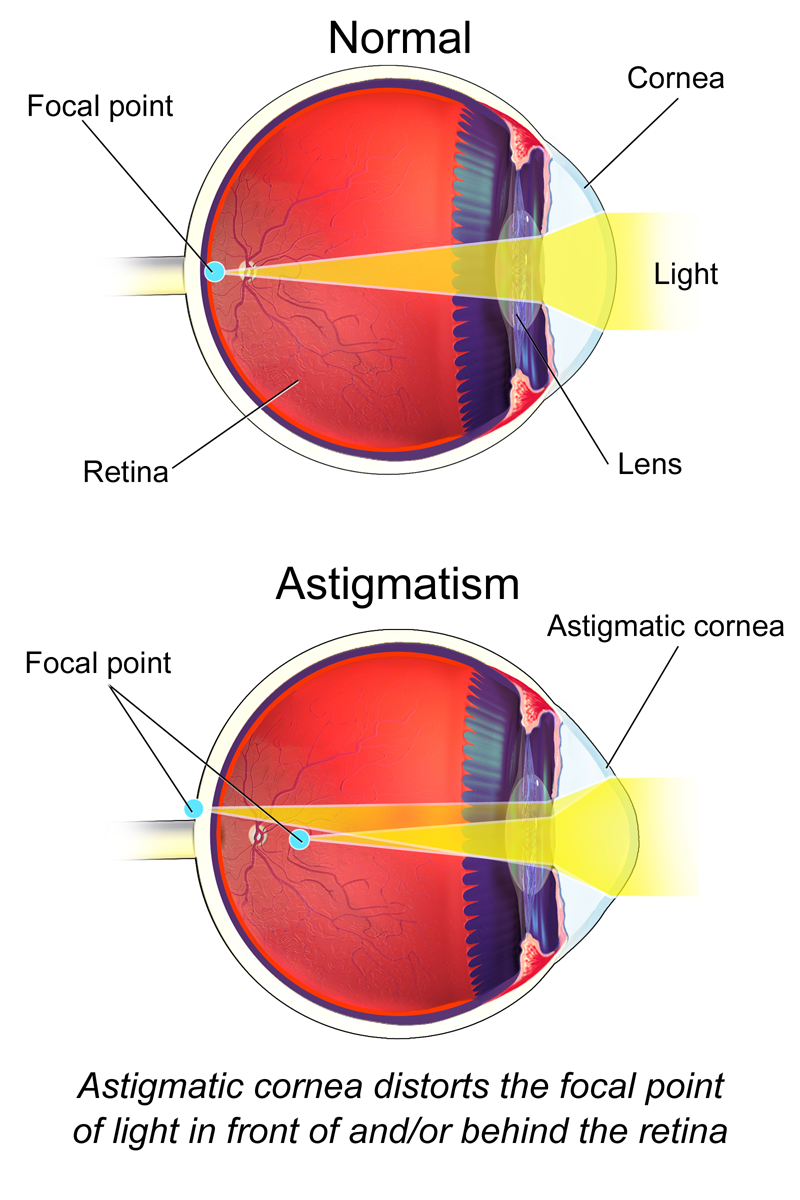Astigmatism – you’ve probably heard of it, you might even have it, but what actually is it? Let’s find out.
What is astigmatism?
You might’ve guessed already from the title (or hearing the term bandied about in an optometrist’s office), but astigmatism is an eye problem that leads those with it to have symptoms including blurry vision.
The problem is caused by the shape of the eye. Normally, the eyes are pretty much spherical – but in those with astigmatism, they’re more like the shape of a rugby ball (or American football). This can be either horizontal, where the eye is wider than it is tall; or vertical, where it’s taller than it is wide.

An illustration of how astigmatism works.
Astigmatism affects the shape of two parts of the eye: the cornea, the transparent layer at the front of the eye; or the lens, the part of the eye that helps to focus light on the retina (the light-sensitive layer at the back of the eye that sends signals to the brain so that you can see).
An abnormally shaped cornea or lens means that light entering the eye doesn’t bend (the fancy term is “refract”) as it should, so it ends up focusing both in front of and behind the retina. The result is blurry vision when looking at things at any distance away.
What are the symptoms?
As well as everything looking a bit blurry, people with astigmatism might experience symptoms like headaches, eye strain, and problems seeing at night. They might also find themselves squinting more than other people do in an attempt to see more clearly.
However, not everyone with astigmatism will have these symptoms, particularly if it’s a mild case.
What causes it?
One 2018 review estimated that the prevalence of astigmatism in World Health Organization regions is 40.4 percent in adults and 14.9 percent in children, although this varied between regions.
However, no one really knows exactly what causes it (at least, for the most part – in some cases it can arise due to eye injury, disease, or surgery).
However, it’s more usual for it to be something that someone is born with, or that they develop during childhood or young adulthood. In these circumstances, genetics might be involved; astigmatism tends to run in families.
There’s also a common misconception that astigmatism can be caused by two things many of us will have been told off for doing as kids – sitting too close to the television or reading in low light. Feel free to text your parents letting them know you were fine all along, because both are actually myths.
How is it treated?
Not everyone who has astigmatism will need treatment – for some people, it’s so mild that it doesn’t affect their vision. However, in cases where treatment is required, the simplest way is with corrective lenses, aka glasses or contact lenses (or maybe cheese crackers at a push). These help to focus the light going into the eye into the correct place, which means bye-bye blurry vision.
The other main option is surgery. There are a bunch of different types, but they all generally work to reshape the cornea, which corrects the abnormality in how light is bent. However, surgery does come with some risks, including either under- or overcorrecting the astigmatism, infection, lights looking like they have a halo around them, and vision loss in rare cases.
One avenue of treatment isn’t considered to be “better” than the others – it’s whatever works best for the individual, and it’s recommended you discuss your options with a doctor.
All “explainer” articles are confirmed by fact checkers to be correct at time of publishing. Text, images, and links may be edited, removed, or added to at a later date to keep information current.
The content of this article is not intended to be a substitute for professional medical advice, diagnosis, or treatment. Always seek the advice of qualified health providers with questions you may have regarding medical conditions.
Source Link: Astigmatism: Here’s What To Know About This Common Eye Condition